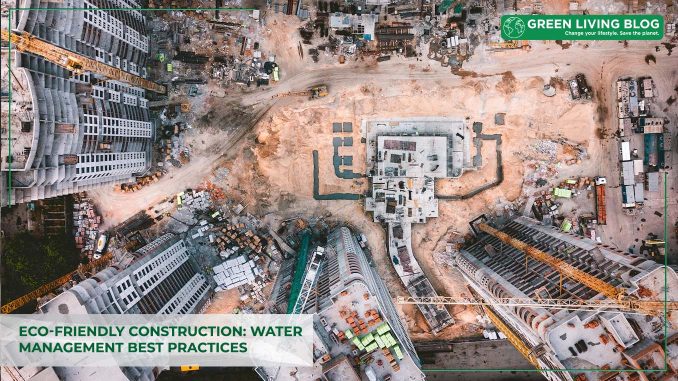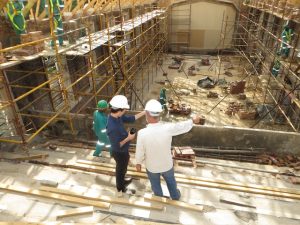
In the face of climate change and resource depletion, eco-friendly construction is imperative.
Sustainable building practices are rapidly moving from the fringe to the forefront of the construction industry, driven by both environmental consciousness and economic benefits. Central to these practices is the management of one of our most precious resources: water.
Effective water management in construction goes beyond mere conservation. It encompasses a comprehensive approach that includes the use of water-saving technologies, recycling, and quality control, ensuring that every drop is used as efficiently as possible.
This shift is critical in an industry where conventional methods are marked by significant water waste. For instance, the construction sector accounts for a high percentage of municipal water use, with vast amounts lost to inefficiencies and pollution.
Recognizing the need for change, this article delves into the best practices for water management in eco-friendly construction, offering insights into how the industry can evolve to meet the demands of the future while preserving the environment today.
The Importance of Water Management in Construction

Water management is a cornerstone of sustainable construction, with far-reaching implications for both the environment and industry. The construction sector’s water use significantly impacts local water cycles, affecting everything from the availability of potable water to the health of aquatic ecosystems. Excessive water use in construction contributes to water scarcity, while runoff from construction sites can carry pollutants, sediment, and debris into waterways, degrading water quality and harming wildlife.
In response to these environmental challenges, rigorous water management strategies have become integral to green building certifications such as the Leadership in Energy and Environmental Design (LEED). LEED-certified buildings are designed to use water efficiently, reducing the overall water footprint of the construction and operation phases. By adhering to LEED standards, construction projects can minimize their impact on the surrounding environment, conserve water, and set a precedent for responsible resource management.
Effective water management in construction not only preserves essential resources but also aligns with global sustainability goals. It demonstrates an industry-wide commitment to stewardship and positions construction firms as leaders in the transition to a more sustainable future.
Best Practices in Water Management for Construction
Water-Saving Fixtures and Fittings
In the quest for water efficiency, the adoption of low-flow taps, and dual-flush toilets is a no-brainer for construction projects. These fixtures significantly reduce water usage without compromising functionality. By installing water-efficient fixtures, construction projects can cut down on the excessive consumption that characterizes traditional building practices.
Rainwater Harvesting Systems
Rainwater harvesting is a game-changer for reducing reliance on municipal supplies. By capturing and storing rainwater, construction sites can utilize this abundant natural resource for activities like irrigation, flushing toilets, and even certain stages of building, easing the strain on community water systems.
Recycling Greywater
Greywater recycling involves the treatment and reuse of water from sinks, showers, and laundries. Implementing on-site greywater systems allows for the repurposing of this resource for landscape irrigation and other non-potable uses, presenting a sustainable solution that reduces the total water demand of construction operations.
Proper Soil Management
Effective soil management is crucial for protecting water quality. Strategies such as silt fences, sediment basins, and buffer zones prevent erosion and sedimentation, safeguarding nearby streams and rivers from construction-related pollution.
Dust Suppression Techniques
Dust is more than just a nuisance; it’s a water management issue. Suppressing dust through water-efficient practices, such as moisture control or environmentally safe chemical suppressants, not only conserves water but also helps maintain air quality and reduces the negative impact on nearby land and water ecosystems.
By implementing these best practices, the construction industry can significantly improve its water management, contributing to the sustainability of the built environment and the natural world alike.
Challenges and Solutions
Challenges in Water Management for Construction
Implementing effective water management in construction is not without its hurdles. One of the primary challenges is the initial cost and complexity of installing advanced water-saving systems. Additionally, the lack of awareness and training among construction professionals can lead to resistance and slow adoption rates. Regulatory barriers and the difficulty in quantifying the immediate benefits of water management practices also pose significant challenges.
Solutions to Water Management Challenges
To overcome these obstacles, strategic planning and investment in education are essential. The following solutions can pave the way for better water management in construction:
- Investment in Education: Construction firms should invest in training their workforce on the importance and operation of water-efficient practices and systems.
- Community Engagement: By involving the community and local stakeholders, construction projects can foster a collaborative approach to sustainable water use.
- Incentivizing Sustainable Practices: Governments and industry bodies can offer incentives for projects that demonstrate water efficiency, encouraging wider adoption.
- Regulatory Support: Streamlining the approval process for innovative water management systems can facilitate their integration into new projects.
- Long-Term Planning: Emphasizing the long-term cost savings and environmental benefits can help justify the upfront investment in water management technologies.
- Public-Private Partnerships: Collaborations between public entities and private firms can lead to shared benefits and resources, promoting sustainable practices.
By addressing these challenges with proactive and collaborative solutions, the construction industry can make significant strides in water management, leading to more sustainable development and a healthier environment.
Conclusion
This discussion has underscored the pivotal role of water management in the pursuit of eco-friendly construction. By embracing water-saving fixtures, harvesting rainwater, recycling greywater, managing soil effectively, and implementing dust suppression techniques, the construction industry can significantly reduce its environmental footprint.
The importance of these practices cannot be overstated. They represent not just a commitment to sustainability but also a strategic response to the growing demand for responsible construction. With water scarcity becoming an increasingly pressing issue globally, efficient water use in construction is a clear path forward.
![]()
Author Profile

- Eco Warrior by day, Eco Blogger by night trying to get the eco balance right.
Latest entries
 EnvironmentJuly 9, 2025Does Double Glazing Help Increase Your EPC Rating?
EnvironmentJuly 9, 2025Does Double Glazing Help Increase Your EPC Rating? Green LivingJune 30, 2025Herbal Tea for Insomnia: Your Guide to Natural, Sustainable Sleep Solutions
Green LivingJune 30, 2025Herbal Tea for Insomnia: Your Guide to Natural, Sustainable Sleep Solutions EnvironmentJune 24, 2025What are the most energy-efficient Home Upgrades in 2025?
EnvironmentJune 24, 2025What are the most energy-efficient Home Upgrades in 2025? EnvironmentJune 23, 2025Eco-Friendly Paper Straws: A Small Switch That Speaks Volumes for your Brand
EnvironmentJune 23, 2025Eco-Friendly Paper Straws: A Small Switch That Speaks Volumes for your Brand







Leave a Reply
You must be logged in to post a comment.